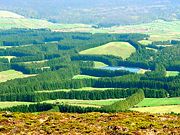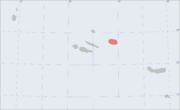Terceira Island
 Serra de Santa Bárbara |
|
| Geography | |
|---|---|
 |
|
| Location | Atlantic Ocean |
| Archipelago | Azores Islands |
| Area | 396.75 km² |
| Highest point | Santa Bárbara (1023 m) |
| Country | |
| Autonomous Region | Azores Islands |
| Largest city | Angra do Heroísmo (35,581) |
| Demographics | |
| Population | 54,996 |
| Density | 140.73/km² people/km2 |
Terceira Island (pron. IPA: [tɨɾ'sɐiɾɐ], Portuguese: Ilha Terceira) is an island in the Azores, in the middle of the North Atlantic Ocean, with an area of 396.75 km². The island's length is 29 km and the width is 18km; the perimeter is 90 km. Population is 54,996, down from a peak of 59,000. Population density is 140.73/km².
Terceira’s coast is dotted with quaint fishing towns, beaches and lava rocks. To the north are both a rocky coast and a mix of forest and vineyards. To the South are cattle grazing lands and the coastal area surrounding Angra, with its parks and hotels. The wide bay and beach at the pretty town of Praia da Vitória are well worth a visit, as is the lake at Caldeira de Guilherme Moniz, which is the biggest body of water in the Azores after to the ocean.
Away from the coast, Terceira is a wild and hilly landscape perfect for walking or hiking. Much of the interior of the island is a nature reserve. From the heights of the Serra do Cume, a visitor can look down on a patchwork of small farms, stonewalls and grazing cattle.
Terceira is also the site of more than 230 traditional bullfights throughout the summer. Every weekend from April to late fall the people of Terceira hold touradas à corda – a form of “running of the bulls.” The bull is let loose from the town’s main square with a very long rope around its neck. The idea is that courageous people will try to get as close to a bull as they dare. After the excitement, the bull is taken back to the wooden crate and an outdoor festival begins. This kind of event is found only in the Azores and has been popular here since 16th Century.
Sometimes in the larger towns, a Portuguese equestrian bullfight (will take place after the touradas á corda. In a Portuguese bullfight a cavaleiro, or rider, takes to the arena atop a Lusitano breed of horse. He's dressed in a silk jacket embroidered with gold and lace, wearing tan riding pants and black boots. The goal of the cavaleiro and his horse is not to kill the bull, but to draw the bull to a charge and then to place a single, harmless dart in the bull’s back muscle.
Contents |
Geography and geology
Terceira Island consists of four overlapping stratovolcanoes built above a geologic rift called the Terceira Rift. The volcanos rise from a depth of over 1,500 metres (5,000 ft) on the floor of the Atlantic Ocean. The oldest at over 300,000 years is the Cinquo Picos stratovolcano that forms the eastern part of the island, with a 7 km (4 mi) diameter caldera which is one of the largest in the Azores. Next in age at perhaps 100,000 years is the Guilherme Moniz stratovolcano in the south-central part of the island, which also has a caldera with the highest remaining point on the rim reaching 623 metres (2,044 ft). Just to its north is the Pico Alto stratovolcano, probably less than 60,000 years old. It once had a caldera too, but subsequent eruptions filled it with several smaller lava domes and cones which top out at 808 m (2,651 ft).
The youngest and only historically active volcano is Santa Bárbara, which comprises the western end of the island and is its highest point at 1,023 m (3,356 ft). This stratovolcano is truncated by two calderas, the youngest of which formed about 15,000 years ago. Historical eruptions occurred in 1761 along a fissure on the east side of the volcano, and in 1867 and 1998–2000 from submarine vents off the west coast. The western part of Terceira Island is more heavily forested than the eastern part, due to the prevailing westerly winds bringing increased precipitation to that side.
Most of the island is ringed by coastal cliffs about 20 m (60 ft) high, except on the south coast near Angra do Heroísmo. Here, an eruption of basaltic lava in shallow water formed the tuff cone of Monte Brasil, which protects and shelters the harbor of the island's capital. The cone is about 1 km (0.6 mi) in diameter and rises 205 m (673 ft) above the western side of the harbor.
Communities and economy
Terceira Island is divided into the municipalities of Angra do Heroísmo and Praia da Vitória. Angra do Heroísmo, the historical capital of the Azores, is the oldest city in the Azores, dating back to 1534. Its historical centre is classified by UNESCO as a World Heritage Site.
The main economic activity in Terceira Island is raising livestock and dairy-based products. The island has two sea ports, one at Angra do Heroísmo and the other at Praia da Vitória, and an air force base (Air Base No. 4) and airport near the town of Lajes.
History
The former name of Terceira Island was Brazil, not to be confused with the country of the same name nor the phantom island of Brazil. That name first appeared as I. de Brazi in the Venetian map of Andrea Bianco (1436), attached to one of the larger islands of the Azores. When the islands became better known and were colonized, the island of Brazil was renamed Terceira (meaning 'third' in Portuguese, as in 'the third island').
An annual event held daily from 1 May to 30 September is the tourada à corda (bullfight with ropes). It consists of letting a bull, tied to a rope, loose in the streets with some controlling the rope and some challenging the bull. Touradas may be held up to three times a day.
Francisco Ferreira Drummond (21 January 1796 - 11 September 1858), Portuguese historiographer, paleographer and musician, was born on Terceira Island. In 1810, a number of journalists and others considered to favour the French, including the industrialist Jácome Ratton, were exiled to the island for a period.
On 24 August 2001, Terceira Island made the news as Air Transat Flight 236 managed to land on Lajes Air Base after running out of fuel in mid-air.
On 16 March 2003, President of the United States George W. Bush, UK Prime Minister Tony Blair, Spanish Prime Minister José María Aznar and Prime Minister of Portugal José Manuel Barroso met on Terceira to discuss the Invasion of Iraq, which began four days later, on 20 March.
See also
- List of volcanoes in Azores
- Biscoitos IPR
References
- Scarth, Alwyn; Tanguy, Jean-Claude (2001). Volcanoes of Europe. Oxford University Press. pp. 243 pp. ISBN 0-19-521754-3.
- Global Volcanism Program: Terceira
External links
- In English:
- Azorean History regarding the American Military
- (English) The Azores Islands, Site about Portuguese Azores Islands
|
||||||||||||||||||||||
|
|||||||||||||||||||||||||||||||||||||
